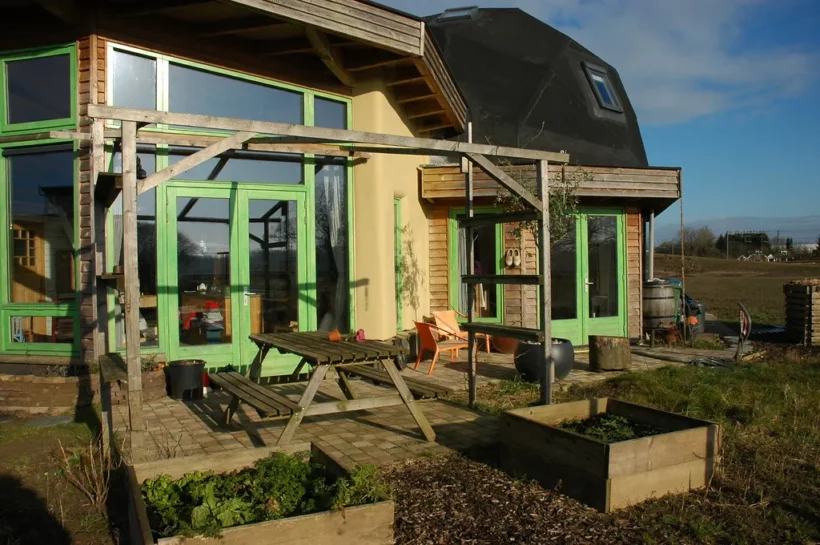 By Erin Yu
By Erin Yu
Characterized by a distinctive architecture of domes and glass panels, the Aardehuizen is a picturesque community of 23 homes located in Olst, Netherlands that was completed back in 2015. Otherwise known as an “ecovillage,” the Aardehuizen was designed around a philosophy of sustainability and self-sufficiency inspired by earthships (homes designed from recyclable ‘garbage’ like steel cans) of the 1970s. Twenty-three families built these ecovillage homes out of sustainable material such as rammed earth and straw that were compacted tightly to provide a strong foundation. They equipped their roofs with solar panels and also furnished their homes with solar collector plates and electric boilers to meet further energy demands. Some residents elected to install additional technologies including heat pumps, pellet stoves, and heat exchangers.
As opposed to each house functioning as a separate entity, the Aardehuizen works as a community microgrid that distributes power across all 23 homes. There is a single smart meter per household, and each house has its own individual meter connection. As a whole, the neighborhood is connected to a single Low Voltage Transformer. The Aardehuizen community grid is decentralized, which allows the community to go off-grid, providing critical energy during outages or public utility failures.
The keys to Aardehuizen’s success
There are few other ecovillages around the globe that have been built at a scale as successful as the Aardehuizen. The scarcity of communities like the Aardehuizen raises the question, Why did Olst, Netherlands become the ideal location for a sustainable community when so many other locations have fallen short? Several factors have contributed to the Aardehuizen’s success — among which social organization plays the largest role.
To begin, the Aardehuizen residents organized themselves in a collectif particulier opdrachtgeverschap (a “CPO”) which allowed them to collectively commission the construction of a private housing development project. The CPO granted the residents control over the design and construction of their village. With complete control over the process, the residents had the flexibility to find their own contractors, helping them save money and create ambitious energy-efficient home designs.
In addition to assembling themselves into a legal entity, the residents also organized themselves in a sociocracy — a style of governance centered around discussion-led decision making and team consensus rather than voting. Another crucial element of sociocracy involves the division of a community into various committees with different responsibilities, such as construction and finance. By means of a sociocracy, the Aardehuizen residents were able to navigate a complex housing project with minimal conflict and effectively divide up the workload for speedier success. The social structure of the Aardehuizen played a key role in its success and could serve as a model for future communities.
Taking the Aardehuizen to the next level
Currently, the Aardehuizen community can produce 32% of the total energy it uses. While this level of local power generation is already commendable, one man – an energy systems engineer named Florijn de Graaf – had bolder visions to drastically increase the Aardehuizen’s energy efficiency. He conducted a case study of the village and recognized that although the Aardehuizen’s current energy system was impressive, he could make a few additions to maximize energy efficiency.
De Graaf’s solution lies in a new approach called Smart Integrated Decentralized Energy (SIDE) Systems. A SIDE system is a self-sufficient energy system that integrates thermal and power technologies at a high level. According to his 2018 report “New Strategies for Decentralized Energy Systems,” the SIDE acronym stands for:
- Smart: managed intelligently through a local energy management system.
- Integrated: maximizing synergies between all components.
- Decentralized: the system operates at the local level and has a clear system boundary.
- Energy: heat and power systems powered by sustainable technologies.
Essentially, a SIDE system attempts to incorporate as many technologies and components into one energy process as possible. For example, instead of installing entirely separate heat and power systems, De Graaf opts for a model that integrates thermal and electricity systems. Fueled by biomass, this system would produce heated water while producing electricity and transport this water through pipes to warm homes. In warm weather, solar PV replaces a combined heat and power system (CHP) and provides electricity to heat or cool homes via heat pumps. In addition to a CHP system, De Graaf also hopes to eventually incorporate electric vehicles in the village to further promote back-up energy storage and off-grid performance.
Aardehuizen: Paving the way towards a greener future
De Graaf projects that with implementation of SIDE systems, the Aardehuizen could locally generate 89% of the energy used. Although seemingly drastic, a design such as De Graaf’s could become a key component in pushing the Netherlands closer to reaching its goal of reducing carbon emissions by 95% by 2050. SIDE systems also present the very real possibility of local communities like the Aardehuizen becoming entirely self-sufficient in the near future. Both the Aardehuizen community and De Graaf’s bold proposals can serve as a model for future community-level microgrids. The Aardehuizen’s current incorporation of solar and thermal systems as well as its sociocratic governance demonstrate how neighborhoods or small towns can successfully transition to renewable energy and increase energy efficiency.
Image credit: Aardehuizen Olst (Flickr)
Erin Yu is a rising sophomore at Duke University studying Environmental Science & Policy and English. She spent this summer as an intern with SmartBlock Communities, where she researched government and utility-based incentive programs for renewable energy and created an energy audit guide to assist homeowners with energy efficiency in their homes.
Editor’s note: this article originally appeared on the EcoBlock blog



Leave a Reply